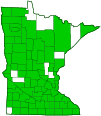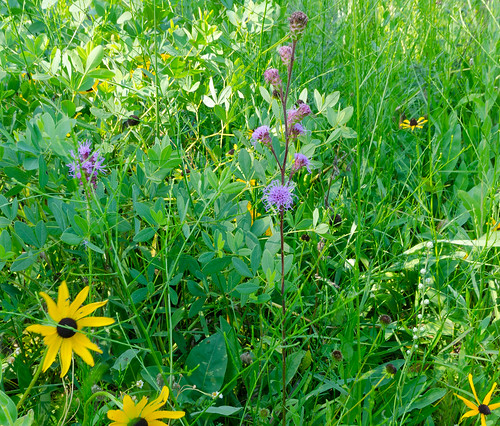northern plains blazing star
(Liatris ligulistylis)
Conservation • Wetland • Description • Habitat • Ecology • Use • Distribution • Taxonomy
Description |
||
Northern plains blazing star is an erect, 8″ to 40″ tall, perennial forb that rises from a large, almost globe-shaped corm. The stems are erect and unbranched. They are sparsely to densely covered with short, soft, curled hairs. Basal leaves are narrowly inversely lance-shaped to spatula lance-shaped, 3½″ to 6″ long, and ⅛″ to ⅝″ wide. They are on long leaf stalks. They have 1 main vein. The margins are untoothed. Lower and middle stem leaves are similar, alternate, becoming gradually smaller and on shorter leaf stalks as they ascend the stem. There are 8 to 100 stem leaves below the inflorescence. Above the middle the leaves become abruptly smaller. Upper stem leaves are similar to middle stem leaves but are linear or narrowly lance-shaped, ascending to nearly erect, and bract-like. They become stalkless and gradually smaller as they ascend the stem. The inflorescence is an unbranched, elongated, spike-like cluster (raceme) of flower heads at the end of the stem. The raceme may have 1 to 21 flower heads, but usually has 3 to 10. The heads are loosely spaced and the axis of the inflorescence is visible between the heads. They are on ascending, 5 ⁄16″ to 1 3 ⁄16″ long stalks. The flower heads are about 1″ wide. The terminal head is often larger than the others and matures first. The whorl of bracts at the base of the flower head (involucre) is broadly bell-shaped to hemispherical, ⅜″ to ⅝″ long, and ½″ to 11 ⁄16″ in diameter. The bracts making up the involucre are in 4 or 5 overlapping series. They are broadly inversely egg-shaped to oblong spatula-shaped. The lower (outer) and middle series are spreading or bent backward. They have rounded, blistery projections on the back, making them appear inflated. They have broad, thin, purple to transparent margins. The margins are strongly bent upwards and appear irregularly torn. The flower head has 30 to 70 pink, tubular disk florets and no ray florets. Each disk floret is separated at the tip into 5 spreading lobes. There are 5 stamens concealed within the corolla tube and a long, white to pink, forked style that protrudes well beyond the tip of the corolla tube. There is no fragrance. The fruit is an achene with hair-like bristles attached. The bristles are barbed, though this may be difficult to see without a hand lens. |
||
Height |
||
8″ to 40″ |
||
Flower Color |
||
Pink |
||
Similar Species |
||
Rough blazing star (Liatris aspera) flower heads are on shorter stalks. |
||
Habitat |
||
Moderate moisture to moist. Prairies, wood openings, meadows, lake shores, streambanks, roadsides, ditches. Full sun. |
||
Ecology |
||
Flowering |
||
August to September |
||
Pests and Diseases |
||
|
||
Use |
||
|
||
Distribution |
||||
|
Sources |
|||
| 4/6/2023 | ||||
Nativity |
||||
Native |
||||
Occurrence |
||||
|
||||
Taxonomy |
|||
| Kingdom | Plantae (Plants) | ||
| Subkingdom | Pteridobiotina | ||
| Phylum | Tracheophyta (Vascular Plants) | ||
| Class | Magnoliopsida (Dicots) | ||
Order |
Asterales (Sunflowers, Bellflowers, Fanflowers, and Allies) | ||
Family |
Asteraceae (Sunflowers, Daisies, Asters, and Allies) | ||
| Subfamily | Asteroideae | ||
| Tribe | Eupatorieae (bonesets, blazingstars, and allies) | ||
| Subtribe | Liatrinae | ||
Genus |
Liatris (blazing stars) | ||
Subordinate Taxa |
|||
|
|||
Synonyms |
|||
| Lacinaria ligulistylis | |||
Common Names |
|||
northern plains blazing star northern plains blazing-star northern plains gayfeather Rocky Mountain blazing star Rocky Mountain gayfeather round-headed blazing star showy blazing-star strap-style gayfeather |
|||
Glossary
Achene
A dry, one-chambered, single-seeded seed capsule, formed from a single carpel, with the seed attached to the membranous outer layer (wall) only by the seed stalk; the wall, formed entirely from the wall of the superior ovary, does not split open at maturity, but relies on decay or predation to release the contents.
Bract
Modified leaf at the base of a flower stalk, flower cluster, or inflorescence.
Corm
A short, solid, vertical, thickened, underground stem that serves as a storage organ.
Corolla
A collective name for all of the petals of a flower.
Involucre
A whorl of bracts beneath or surrounding a flower, flower head, or flower cluster.
Linear
Long, straight, and narrow, with more or less parallel sides, like a blade of grass.
Plumose
Feathery; having fine, pinnately arranged, lateral bristles or hairs arranged on both sides of an axis.
Raceme
An unbranched, elongated inflorescence with stalked flowers. The flowers mature from the bottom up.
Visitor Photos |
|||||
Share your photo of this plant. |
|||||
| This button not working for you? Simply email us at info@MinnesotaSeasons.com. Attach one or more photos and, if you like, a caption. |
|||||
|
|||||
MinnesotaSeasons.com Photos |
|||||
Plant |
|||||
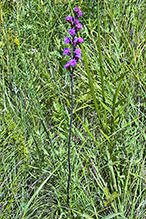 |
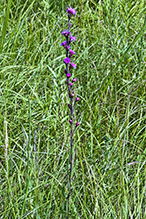 |
||||
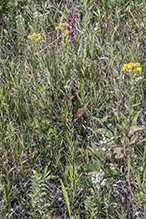 |
|||||
Inflorescence |
|||||
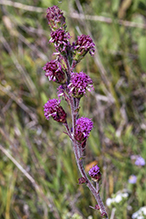 |
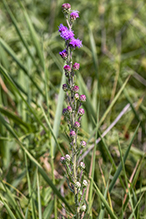 |
||||
Flower Heads |
|||||
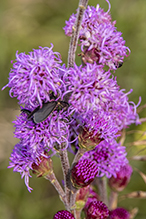 |
|||||
Infructescence |
|||||
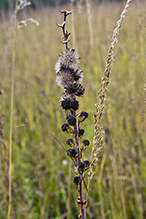 |
|||||

Visitor Videos |
|||
Share your video of this plant. |
|||
| This button not working for you? Simply email us at info@MinnesotaSeasons.com. Attach a video, a YouTube link, or a cloud storage link. |
|||
Other Videos |
|||
| Best Butterfly Plant Ionxchange |
|||
About
Published on Aug 24, 2012 Earthyman views the best butterfly plant at Ion Exchange, native seed and plant nursery in NE Iowa. Meadow Blazingstar (Liatris ligulistylis) will attract butterflies to your prairie perennial garden. Blazingstar is a perennial prairie wildflower. http://ionxchange.com/products/LIATRIS-LIGULISTYLIS-%7C-Meadow-Blazingstar.html |
|||
| Monarch Butterflies Mating on Liatris Tony Gomez |
|||
About
Uploaded on Aug 1, 2010 http://monarchbutterflygarden.net/purple-butterfly-flower-power/ monarch butterflies mating on a favorite purple plant (liatris ligulistylis). Read the article to learn about 4 more popular purple flowers for your butterfly garden, |
|||
| Monarch swarm while walking through a patch of Meadow Blazing Stars Blazing Star Gardens |
|||
About
Published on Sep 19, 2013 There were at least two dozen monarchs and other butterflies in this patch of Meadow Blazing Stars every day for the 3-4 weeks they were blooming. A native prairie flower, Meadow Blazing Star is one of the best Midwestern plants for attracting monarchs, which feed on the nectar. This video was taken on 8/31/2013 in a patch of native Meadow Blazing Star (Liatris ligulistylis) flowers in a road ditch near Albert Lea, Minnesota. Don't worry, no Blazing Stars were seriously injured in the making of this video, as I was watching where I stepped while filming. |
|||
| Monarchs Nectaring On Meadow Blazingstar Winthrop, Minnesota Aug. 28, 2013 4af |
|||
About
Published on Aug 31, 2013 New Project 35 |
|||

Visitor Sightings |
|||||
Report a sighting of this plant. |
|||||
| This button not working for you? Simply email us at info@MinnesotaSeasons.com. Be sure to include a location. |
|||||
|
|||||
MinnesotaSeasons.com Sightings |
|||||
Badoura Jack Pine Woodland SNA Carver Highlands WMA, South Unit Felton Prairie SNA, Shrike Unit Margherita Preserve-Audubon Prairie Mound Spring Prairie SNA, North Unit Northern Tallgrass Prairie NWR, Pavia Unit Northern Tallgrass Prairie NWR, Spieker Unit Pembina Trail Preserve SNA, Crookston Prairie Unit Richard M. & Mathilde Rice Elliott SNA |
|||||

|
Created: Last Updated: © MinnesotaSeasons.com. All rights reserved. |
